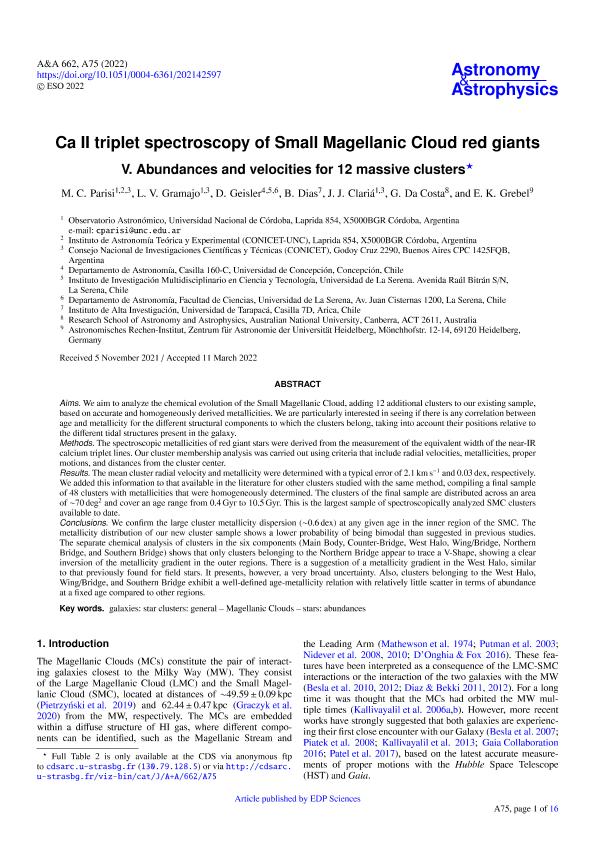Mostrar el registro sencillo del ítem
dc.contributor.author
Parisi, Maria Celeste

dc.contributor.author
Gramajo, Luciana Veronica

dc.contributor.author
Geisler, D.
dc.contributor.author
Dias, B.
dc.contributor.author
Clariá, Juan José

dc.contributor.author
Da Costa, G.
dc.contributor.author
Grebel, E. K.
dc.date.available
2023-08-09T12:41:40Z
dc.date.issued
2022-06
dc.identifier.citation
Parisi, Maria Celeste; Gramajo, Luciana Veronica; Geisler, D.; Dias, B.; Clariá, Juan José; et al.; Ca II triplet spectroscopy of Small Magellanic Cloud red giants: V. Abundances and velocities for 12 massive clusters; EDP Sciences; Astronomy and Astrophysics; 662; 6-2022; 1-16
dc.identifier.issn
0004-6361
dc.identifier.uri
http://hdl.handle.net/11336/207552
dc.description.abstract
Aims. We aim to analyze the chemical evolution of the Small Magellanic Cloud, adding 12 additional clusters to our existing sample, based on accurate and homogeneously derived metallicities. We are particularly interested in seeing if there is any correlation between age and metallicity for the different structural components to which the clusters belong, taking into account their positions relative to the different tidal structures present in the galaxy. Methods. The spectroscopic metallicities of red giant stars were derived from the measurement of the equivalent width of the near-IR calcium triplet lines. Our cluster membership analysis was carried out using criteria that include radial velocities, metallicities, proper motions, and distances from the cluster center. Results. The mean cluster radial velocity and metallicity were determined with a typical error of 2.1 km s-1 and 0.03 dex, respectively. We added this information to that available in the literature for other clusters studied with the same method, compiling a final sample of 48 clusters with metallicities that were homogeneously determined. The clusters of the final sample are distributed across an area of ∼ 70 deg2 and cover an age range from 0.4 Gyr to 10.5 Gyr. This is the largest sample of spectroscopically analyzed SMC clusters available to date. Conclusions. We confirm the large cluster metallicity dispersion (∼ 0.6 dex) at any given age in the inner region of the SMC. The metallicity distribution of our new cluster sample shows a lower probability of being bimodal than suggested in previous studies. The separate chemical analysis of clusters in the six components (Main Body, Counter-Bridge, West Halo, Wing/Bridge, Northern Bridge, and Southern Bridge) shows that only clusters belonging to the Northern Bridge appear to trace a V-Shape, showing a clear inversion of the metallicity gradient in the outer regions. There is a suggestion of a metallicity gradient in the West Halo, similar to that previously found for field stars. It presents, however, a very broad uncertainty. Also, clusters belonging to the West Halo, Wing/Bridge, and Southern Bridge exhibit a well-defined age-metallicity relation with relatively little scatter in terms of abundance at a fixed age compared to other regions.
dc.format
application/pdf
dc.language.iso
eng
dc.publisher
EDP Sciences

dc.rights
info:eu-repo/semantics/openAccess
dc.rights.uri
https://creativecommons.org/licenses/by-nc-sa/2.5/ar/
dc.subject
GALAXIES: STAR CLUSTERS: GENERAL
dc.subject
MAGELLANIC CLOUDS
dc.subject
STARS: ABUNDANCES
dc.subject.classification
Otras Ciencias Naturales y Exactas

dc.subject.classification
Otras Ciencias Naturales y Exactas

dc.subject.classification
CIENCIAS NATURALES Y EXACTAS

dc.title
Ca II triplet spectroscopy of Small Magellanic Cloud red giants: V. Abundances and velocities for 12 massive clusters
dc.type
info:eu-repo/semantics/article
dc.type
info:ar-repo/semantics/artículo
dc.type
info:eu-repo/semantics/publishedVersion
dc.date.updated
2023-06-15T18:03:24Z
dc.journal.volume
662
dc.journal.pagination
1-16
dc.journal.pais
Francia

dc.journal.ciudad
Paris
dc.description.fil
Fil: Parisi, Maria Celeste. Consejo Nacional de Investigaciones Científicas y Técnicas. Centro Científico Tecnológico Conicet - Córdoba. Instituto de Astronomía Teórica y Experimental. Universidad Nacional de Córdoba. Observatorio Astronómico de Córdoba. Instituto de Astronomía Teórica y Experimental; Argentina
dc.description.fil
Fil: Gramajo, Luciana Veronica. Consejo Nacional de Investigaciones Científicas y Técnicas. Centro Científico Tecnológico Conicet - Córdoba. Instituto de Astronomía Teórica y Experimental. Universidad Nacional de Córdoba. Observatorio Astronómico de Córdoba. Instituto de Astronomía Teórica y Experimental; Argentina
dc.description.fil
Fil: Geisler, D.. Universidad de Concepción; Chile. Universidad de La Serena; Chile
dc.description.fil
Fil: Dias, B.. Universidad de Tarapacá; Chile
dc.description.fil
Fil: Clariá, Juan José. Consejo Nacional de Investigaciones Científicas y Técnicas. Centro Científico Tecnológico Conicet - Córdoba. Instituto de Astronomía Teórica y Experimental. Universidad Nacional de Córdoba. Observatorio Astronómico de Córdoba. Instituto de Astronomía Teórica y Experimental; Argentina
dc.description.fil
Fil: Da Costa, G.. Australian National University; Australia
dc.description.fil
Fil: Grebel, E. K.. Zentrum für Astronomie der Universität Heidelberg; Alemania
dc.journal.title
Astronomy and Astrophysics

dc.relation.alternativeid
info:eu-repo/semantics/altIdentifier/url/https://www.aanda.org/articles/aa/abs/2022/06/aa42597-21/aa42597-21.html
dc.relation.alternativeid
info:eu-repo/semantics/altIdentifier/doi/http://dx.doi.org/10.1051/0004-6361/202142597
Archivos asociados
